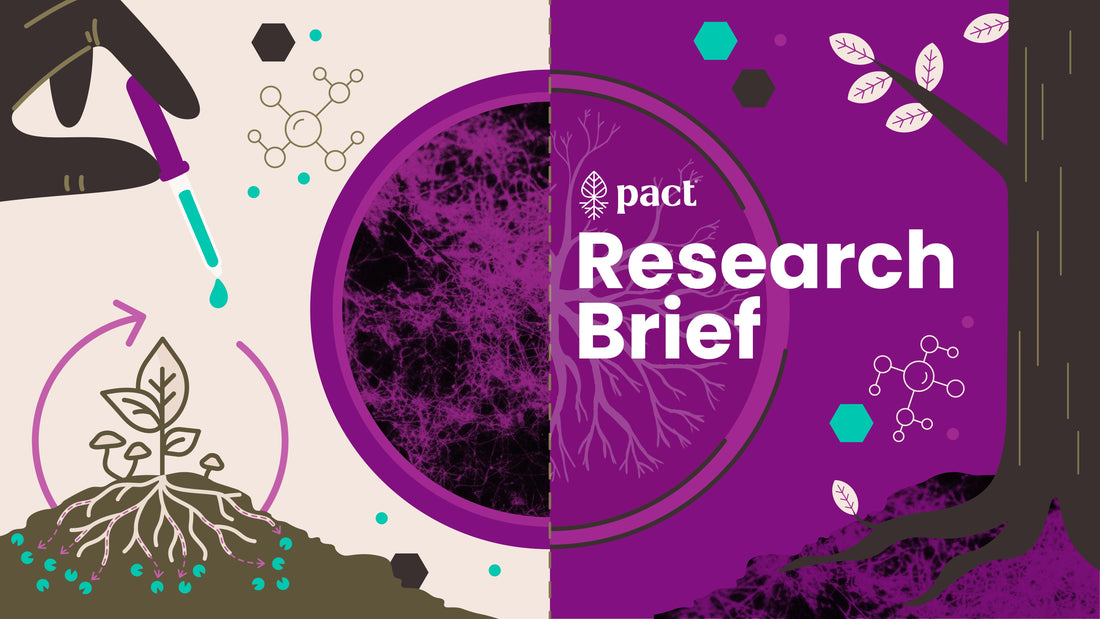
The Characteristics of Stropharia Rugosoannulata
Share
The Essential Role of Saprotrophic Fungi
Stropharia rugosoannulata is a saprotrophic fungi (or saprotroph), meaning it breaks down dead and decaying organic matter. S. rugosoannulata is particularly specialized at decomposing wood, as it is classified as a white-rot or litter-decomposing fungi.

The extracellular enzymes produced by Stropharia rugosoannulata are effective at digesting lignin and cellulose, the main components of most plant matter. Saprotrophs break down organic matter into their “building blocks” (proteins, carbohydrates, lipids, and/or nucleic acids) and consume the glucose, a carbohydrate sugar.
The rest of the broken-down organic matter is left in the soil, where it can be easily taken up by plants or other microbes and decomposers. Saprotrophs like S. rugosoannulata are important to the overall ecosystem functioning and nutrient cycling, as they convert unusable compounds into accessible forms of macronutrients and micronutrients (various elements, metals, molecules, and minerals) that can be used by the surrounding organisms.
These fungi are necessary for energy and nutrient cycling. In an ecosystem without decomposers, energy and nutrients would be lost to the environment and the ecosystem would fail as most plants cannot easily uptake or use organic matter until it is broken down (chemically) by other organisms like saprotrophic fungi.
Saprotrophic versus Parasitic Fungi
The Kingdom of Fungi is estimated to contain millions of different species, filling a wide range of ecological niches, or roles. There are “good” fungi and “bad” fungi. Parasitic fungi, similar to saprotrophs, can produce extracellular enzymes to digest their food. However, parasitic fungi feed on living plants and animals, causing diseases, reduced biological function, and even death. Parasitic fungi infect living hosts and sap them of their nutrients. Parasitic fungi can be zoo-pathogenic (infecting animals) or phyto-pathogenic (infecting plants).
Saprotrophs, the “good” fungi, do not infect and harm living organisms. Decomposer fungi like S. rugosoannulata stick to digesting already dead or decaying matter, providing many ecological benefits like the ones mentioned above. The likelihood of S. rugosoannulata becoming parasitic towards plants or animals is practically zero. Rather, saprotrophic mycelia are working with plants to exchange nutrients and water, which indirectly benefits animals and the ecosystem as a whole. Fantastic Fungi filmmaker Louie Schwartzberg describes this mycelial network as “a shared economy, where ecosystems flourish without greed.”
Stropharia’s Ecosystem Services
Ecosystem services are direct or indirect benefits provided by an organism or group of organisms to their ecosystem.
Fungi in the genus Stropharia support soil health and nutrient cycling through their decomposition activity (Nix 2022). Their role as saprotrophs—breaking down plant debris, wood, and other organic materials—provides nutrients for a wide array of soil organisms. This fosters a complex micro-community that includes bacteria, other fungi, protozoa, nematodes, insects, and larger soil fauna like earthworms. By enriching the soil with organic matter and nutrients, Stropharia fungi also indirectly support plant diversity, which, in turn, sustains the higher trophic levels (herbivores and predators).
Stropharia species can increase biodiversity in other ways as well. Fungal hyphal networks serve as microhabitats (Hoosein et al. 2023), offering substrate for colonization by smaller fungi and bacteria. This promotes microbial biodiversity by creating a mosaic of micro-environments with varying levels of moisture, nutrients, and protection within the soil (Wagg et al. 2019). Stropharia species can also suppress pathogenic fungi and nematodes by outcompeting them for resources, through chemical interactions, or, in the case of S. rugosoannulata, mechanical force by specialized cells called acanthocytes (Luo et al. 2006), allowing beneficial soil microbes and plants to flourish.
Additionally, Stropharia fungi can form associations with plant roots, benefiting plants (Bender 2022) by suppressing soil pathogens and outcompeting harmful fungi. From an agricultural and permaculture perspective, Stropharia rugosoannulata is often cultivated deliberately for its dual role as a food source and a natural enhancer of soil health (Gong 2018). This makes Stropharia fungi not only vital contributors to natural ecosystems, but also valuable allies in sustainable land management.
S. rugosoannulata, are also known for their mycoremediation potential—they can break down harmful pollutants such as hydrocarbons found in fossil fuels (Steffen et al. 2002), pharmaceuticals (Castellet-Rovira et al. 2017), E. coli (Taylor et al. 2015), and other toxic chemicals (Valentín et al. 2013), helping to clean up contaminated environments. S. rugosoannulata further enhances biodiversity by breaking down pollutants in contaminated soils and creating conditions where sensitive species can return and thrive.
Saprotrophic fungi, like S. rugosoannulata, play a vital role in carbon sequestration by breaking down organic matter and incorporating carbon into their biomass and the surrounding soil (Emilia Hannula and Morriën 2022) (Reynolds 2024). As they decompose plant debris, wood, and other organic materials, a portion of the carbon is converted into building fungal tissues, including hyphae and fruiting bodies, which store carbon temporarily. Decomposition enriches the soil with stable organic compounds, creating humus, which can lock carbon in the soil for long periods. This process not only reduces the amount of carbon released as CO₂ into the atmosphere, but also enhances soil fertility, creating a feedback loop that supports plant growth and further carbon capture.
Stropharia’s Habitat Range
Stropharia rugosoannulata is incredibly versatile, growing on forest floors, vegetable gardens, and even in containers or urban/suburban green spaces. S. rugosoannulata grows natively in Europe and the United States (more common in the northeast, east of the Great Plains region), and has been introduced to Asia, New Zealand, and Australia.
Below is a range map from iNaturalist showing verified observations (red) of Stropharia rugosoannulata in the wild and the current known range of S. rugosoannulata at the continental scale (green).

It can be relatively hard to identify the actual range of fungi, as they are difficult to identify without the presence of a fruiting body (i.e. mushroom). Range maps created by iNaturalist are helpful, but not complete. While the maps are constantly updated as observations are reported and verified, iNaturalist has only been collecting data since 2008 and it relies on citizen-science (public participation). It is likely that S. rugosoannulata grows natively (or has been introduced or cultivated) outside of the ranges reported by this map.
Bibliography
-
Bender L. 2022. Quantifying the capacity of Wine Cap mushroom cultivation to enhance soil health, improve vegetable crop value and increase farmer profitability. Sare.org. - LINK
-
Castellet-Rovira F, Lucas D, Villagrasa M, Rodríguez-Mozaz S, Barceló D, Sarrà M. 2017. Stropharia rugosoannulata and Gymnopilus luteofolius: Promising fungal species for pharmaceutical biodegradation in contaminated water. J Environ Manage. 207:396–404. doi:10.1016/j.jenvman.2017.07.052. - LINK
-
Emilia Hannula S, Morriën E. 2022. Will fungi solve the carbon dilemma? Geoderma. 413(115767):115767. doi:10.1016/j.geoderma.2022.115767. - LINK
-
Gong S, Chen C, Zhu J, Qi G, Jiang S. 2018. Effects of wine-cap Stropharia cultivation on soil nutrients and bacterial communities in forestlands of northern China. PeerJ. 6(e5741):e5741. doi:10.7717/peerj.5741. - LINK
-
Hoosein S, Neuenkamp L, Trivedi P, Paschke MW. 2023. AM fungal-bacterial relationships: what can they tell us about ecosystem sustainability and soil functioning? Front Fungal Biol. 4:1141963. doi:10.3389/ffunb.2023.1141963. - LINK
-
Luo H, Li X, Li G, Pan Y, Zhang K. 2006. Acanthocytes of Stropharia rugosoannulata function as a nematode-attacking device. Appl Environ Microbiol. 72(4):2982–2987. doi:10.1128/AEM.72.4.2982-2987.2006. - LINK
-
Nix J. 2022. The role of fungi in a healthy soil microbiome. Biomemakers.com. - LINK
-
Reynolds M. 2024. The world’s largest fungus collection may unlock the mysteries of carbon capture. Wired. - LINK
-
Steffen KT, Hatakka A, Hofrichter M. 2002. Removal and mineralization of polycyclic aromatic hydrocarbons by litter-decomposing basidiomycetous fungi. Appl Microbiol Biotechnol. 60(1–2):212–217. doi:10.1007/s00253-002-1105-6. - LINK
-
Taylor A, Flatt A, Beutel M, Wolff M, Brownson K, Stamets P. 2015. Removal of Escherichia coli from synthetic stormwater using mycofiltration. Ecol Eng. 78:79–86. doi:10.1016/j.ecoleng.2014.05.016. - LINK
-
Valentín L, Oesch-Kuisma H, Steffen KT, Kähkönen MA, Hatakka A, Tuomela M. 2013. Mycoremediation of wood and soil from an old sawmill area contaminated for decades. J Hazard Mater. 260:668–675. doi:10.1016/j.jhazmat.2013.06.014. - LINK
- Wagg C, Schlaeppi K, Banerjee S, Kuramae EE, van der Heijden MGA. 2019. Fungal-bacterial diversity and microbiome complexity predict ecosystem functioning. Nat Commun. 10(1):4841. doi:10.1038/s41467-019-12798-y. - LINK
